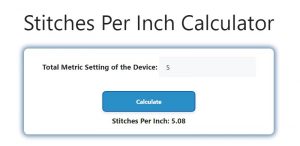About Stitches Per Inch Calculator (Formula)
The Stitches Per Inch (SPI) Calculator is an essential tool for anyone involved in sewing, quilting, or textile arts. This calculator helps you determine the number of stitches in a given length of fabric, allowing for precise adjustments in your sewing projects. Understanding the stitches per inch is crucial for achieving the desired fabric density, ensuring durability, and maintaining the overall quality of your work. This article will cover the formula used for calculating SPI, how to effectively use the calculator, an example for clarity, and answers to frequently asked questions.
Formula
The formula for calculating stitches per inch (SPI) is:
SPI = (Number of Stitches / Length in Inches)
Where:
- Number of Stitches: The total count of stitches within the measured length of fabric.
- Length in Inches: The length of the fabric over which the stitches are measured.
How to Use
- Count Stitches: Begin by counting the total number of stitches you have made over a specific length of fabric.
- Measure Length: Measure the length of the fabric in inches where the stitches are counted.
- Apply the Formula: Use the formula to calculate the stitches per inch by dividing the number of stitches by the length in inches.
Example
Let’s say you have made 40 stitches over a length of 5 inches of fabric. To calculate the SPI:
- Number of Stitches: 40
- Length in Inches: 5
Calculation:
SPI = 40 stitches / 5 inches = 8 stitches per inch
In this example, the stitches per inch would be 8, indicating a moderately dense stitch pattern.

FAQs
- What is Stitches Per Inch (SPI)?
SPI is a measurement that indicates how many stitches are made in one inch of fabric. - Why is SPI important in sewing?
SPI affects the fabric’s durability, appearance, and the overall quality of the finished product. - How do I measure the length of fabric for SPI calculation?
Use a ruler or measuring tape to measure the length of the fabric in inches where the stitches are made. - Can I use this calculator for different types of stitching?
Yes, the SPI calculator is applicable for various stitching techniques, including quilting, embroidery, and garment sewing. - What if I change the thread type or needle size?
Changing the thread type or needle size can impact the SPI; you may want to recalculate after any changes. - Is there an optimal SPI for different fabrics?
Yes, different fabrics and projects may require different SPIs; consult sewing guidelines for recommendations. - How does SPI affect the appearance of my sewing project?
A higher SPI can create a denser fabric appearance, while a lower SPI may yield a looser stitch pattern. - Can I use the SPI calculator for machine and hand sewing?
Absolutely! The SPI calculator can be used for both machine and hand sewing projects. - What tools do I need to calculate SPI?
You’ll need a ruler or measuring tape and a count of your stitches. - How often should I check my SPI?
Check your SPI at the beginning of a project and whenever you change your stitching technique or materials. - Can SPI affect the stretch of the fabric?
Yes, a higher stitch density may affect the fabric’s stretch and flexibility. - How do I improve my SPI?
Practice consistent stitch spacing and consider using a sewing guide or foot to maintain even stitches. - What is the average SPI for quilting?
The average SPI for quilting typically ranges from 8 to 12 stitches per inch, depending on the design and fabric used. - Can I use the SPI calculator for knit fabrics?
Yes, but consider the stretch characteristics of knit fabrics when calculating SPI. - What is the relationship between SPI and thread tension?
Proper thread tension is essential for achieving the desired SPI; incorrect tension can lead to uneven stitching. - How can I test my SPI before starting a project?
Create a test swatch with your chosen stitch pattern and measure the SPI. - Is it necessary to calculate SPI for every project?
While not always necessary, calculating SPI can be beneficial for ensuring consistent results in your projects. - Can I use the SPI calculator for decorative stitching?
Yes, you can calculate SPI for decorative stitches, but consider their visual impact on the fabric. - How does fabric thickness affect SPI?
Thicker fabrics may require a different SPI to maintain an even appearance and structural integrity. - What should I do if I’m not getting the expected SPI?
Review your stitching technique, thread tension, and fabric type, and make adjustments as needed.
Conclusion
The Stitches Per Inch (SPI) Calculator is a vital resource for anyone involved in sewing and textile arts. By accurately calculating SPI, you can achieve the desired fabric density, ensuring the durability and aesthetic appeal of your projects. Understanding how to use the SPI calculator effectively can enhance your sewing skills, leading to more professional and satisfying results in all your textile endeavors. Whether you’re a novice or an experienced sewist, this tool will serve you well in your creative journey.
